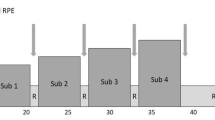Abstract
We measured physiological variables in nine older recreational skiers (62.6 ± 5.1 years) who completed a maximal cycle ergometry test and four different skiing modes via ski instructor-guided skiing at moderate altitude. During testing, we measured heart rate (HR), oxygen uptake (VO2), blood lactate concentration (LA), blood pressure (BP) and ratings of perceived exertion (RPE). The mean values in the laboratory were: HRmax 167 ± 7.9 bpm, VO2peak of 35.7 ± 5.1 ml kg−1 min−1, LAmax 8.9 ± 2.4 mmol l−1 and BP of 228/91 mmHg. The average values of field compared to laboratory test ranged from 48 to 94% of HRmax, VO2 of 22–66% of VO2peak, LA of 0.7–6.0 mmol l−1, RPE during on-snow was 6–17, while BP remained at submaximal level during field tests. Weak correlation was found between laboratory and field tests. Our results suggest that aerobic metabolism predominates on flat and low intensity steep slopes and transitions to anaerobic metabolism on steeper high intensity runs.






Similar content being viewed by others
References
Allen PD, Pandolf KB (1977) Perceived exertion associated with breathing hyperoxic mixture during submaximal work. Med Sci Sports 9(2):122–127
Anderson RE, Montgomery DL (1988) Physiology of alpine skiing. Sports Med 6:210–221
Bacharach DW, von Duvillard SP (1995) Intermediate and long-term anaerobic performance of elite Alpine skiers. Med Sci Sports Exerc 27(3):305–309. doi:10.1249/00005768-199503000-00003
Brooks SV, Faulkner JA (1994) Skeletal muscle weakness in old age: underlying mechanisms. Med Sci Sports Exerc 26(4):432–439. doi:10.1249/00005768-199404000-00006
Coggan AR, Abduljalil AM, Swanson SC et al (1993) Muscle metabolism during exercise in young and older untrained and endurance-trained men. J Appl Physiol 75(5):2125–2133
Demello JJ, Cureton KJ, Boineau RE et al (1987) Ratings of perceived exertion at the lactate threshold in trained and untrained men and women. Med Sci Sports Exerc 19(4):354–362. doi:10.1249/00005768-198708000-00006
Ekblom B, Goldbarg AN (1971) The influence of physical training and other factors on the subjective rating of perceived exertion. Acta Physiol Scand 83(3):399–406
Eriksson A, Forsberg A, Nilsson J (1978) Muscle strength, EMG activity, and oxygen uptake during downhill skiing. In: Asmussen E et al (eds) Biomechanics IV-A. University Park Press, Baltimore, pp 54–61
Green JM, McLester JR, Crews TR et al (2005) RPE-lactate dissociation during extended cycling. Eur J Appl Physiol 94:145–150. doi:10.1007/s00421-004-1311-2
Guyton AC (1987) Renal function curve a key to understanding the pathogenesis of hypertension. Hypertension. 10:1–6. In: Bouchard C, Shepard RJ, Stephens T et al (eds) Exercise fitness and health. Human Kinetics Publishers (UK) Ltd., Leeds
Halliwill JR, Taylor JA, Eckberg DL (1996) Impaired sympathetic vascular regulation in humans after acute dynamic exercise. J Physiol 15:279–288
Hetzler RK, Seip RK, Boutcher SH et al (1991) Effect of exercise modality on ratings of perceived exertion at various lactate concentrations. Med Sci Sports Exerc 23(1):88–92. doi:10.1249/00005768-199101000-00014
Hill L (1897) Arterial pressure in man while sleeping, resting, working and bathing. J Physiol 22:xxvi–xxix
Kahn JF, Jouanin JC, Espirito-Santo J et al (1993) Cardiovascular responses to leisure alpine skiing in habitually sedentary middle-aged men. J Sports Sci 11:31–36. doi:10.1080/02640419308729960
Karlsson J, Eriksson A, Forsberg A et al (1978) The physiology of alpine skiing. United States Ski Coaches Association, Park City
Kimura G, Saito F, Kojima S (1987) Renal function curve in patients with secondary forms of hypertension. Hypertension. 10:11–15. In: Bouchard C, Shepard RJ, Stephens T et al (eds) Exercise fitness and health. Human Kinetics Publishers (UK) Ltd., Leeds
Krautgasser S, Scheiber P, Kroell J et al (2007) Recreational alpine skiing—circumstances and requirements for a beneficial physical activity for elderly. In: Proceedings of the international congress on science and skiing, St Christoph, Arlberg, Austria
MacDonald JR (2002) Potential causes, mechanisms, and implications of post exercise hypotension. J Hum Hypertens 16:225–236. doi:10.1038/sj.jhh.1001377
MacDougall JD (1994) Blood pressure responses to resistive, static and dynamic exercise. In: Fletcher GF (ed) Cardiovascular response to exercise. Futura Publishing, Kisco, pp 155–173
Mattern CO, Gutilla MJ, Bright DL et al (2003) Maximal lactate steady state declines during the aging process. J Appl Physiol 95:2576–2582
Noble BJ, Borg G, Jacobs I et al (1983) A category-ratio perceived exertion scale: relationship to blood and muscle lactates and heart rate. Med Sci Sports Exerc 15(6):523–528. doi:10.1249/00005768-198315060-00015
Nygaard E, Andersen P, Nilsson P et al (1978) Glycogen depletion pattern and lactate accumulation in leg muscles during recreational downhill skiing. Eur J Appl Physiol 38:261–269. doi:10.1007/BF00423108
Palatini P, Guzzardi G, Penzo M et al (1991) Effect of high and low altitude exposure on the blood pressure response to physical exercise. Cardiologia 36(11):853–859
Paterson DH, Cunningham DA, Koval JJ et al (1999) Aerobic fitness in a population of independently living men and women aged 88–86 years. Med Sci Sports Exerc 31(12):1813–1820. doi:10.1097/00005768-199912000-00018
Roeder Y, Vater H, Vater K (2005) Physiological aspects of alpine skiing with differently shaped skis. In: Mueller E et al (eds) Science and skiing III. Meyer & Meyer Sport, Oxford
Rondon MU, Alves MJ, Braga AM et al (2002) Postexercise blood pressure reduction in elderly hypertenisve patients. J Am Coll Cardiol 39(4):676–682. doi:10.1016/S0735-1097(01)01789-2
Saibene F, Cortili G, Gavazzi P et al (1985) Energy sources in alpine skiing (giant slalom). Eur J Appl Physiol 53:312–316. doi:10.1007/BF00422845
Sanada K, Kuchiki T, Miyachi M et al (2007) Effects of age on ventilatory threshold and peak oxygen uptake normalised for regional skeletal muscle mass in Japanese men and women aged 20–80 years. Eur J Appl Physiol 99:475–483. doi:10.1007/s00421-006-0375-6
Scheiber P, Krautgasser S, Kroell J et al (2007) Guided alpine skiing—physiological demands on elderly recreational skiers. In: Proceedings of the international congress on science and skiing, St Christoph, Arlberg, Austria
Schobersberger W, Schmid P, Lechleitner M et al (2003) Austrian Moderate Altitude Study 2000 (AMAS 2000). The effects of moderate altitude (1,700 m) on cardiovascular and metabolic variables in patients with metabolic syndrome. Eur J Appl Physiol 88:506–514. doi:10.1007/s00421-002-0736-8
Seifert J, Kroell J, Mueller E (2007) The relationship of heart rate and lactate to cumulative muscle fatigue during recreational alpine skiing. In: Proceedings of the international congress on science and skiing, St Christoph, Arlberg, Austria
Shephard RJ (2004) Aging. In: LeMura LM, von Duvillard SP (eds) Clinical exercise physiology. Lippincott Williams & Wilkins, Philadelphia
Stathokostas L, Jacob-Johnson S, Petrella RJ et al (2004) Longitudinal changes in aerobic power in older men and women. J Appl Physiol 97:781–789. doi:10.1152/japplphysiol.00447.2003
Tesch PE (1995) Aspects on muscle properties and use in competitive alpine skiing. Med Sci Sports Exerc 27(3):310–314. doi:10.1249/00005768-199503000-00004
Tesch PE, Larsson L, Eriksson A et al (1978) Muscle glycogen depletion and lactate concentration during downhill skiing. Med Sci Sports 10(2):85–90
Thompson LV (1994) Effects of age and training on skeletal muscle physiology and performance. Phys Ther 74(1):71–81
Tzankoff SP, Norris AH (1979) Age-related differences in lactate distribution kinetics following maximal exercise. Eur J Appl Physiol 42:35–40. doi:10.1007/BF00421102
Veglio M, Maule S, Cametti G et al (1999) The effects of exposure to moderate altitude on cardiovascular autonomic function in normal subjects. Clin Auton Res 9(3):123–127
Veicsteinas A, Ferretti G, Margonato GR et al (1984) Energy cost of and energy sources for alpine skiing in top athletes. J Appl Physiol 56(5):1187–1190
Wörndle W (2007) Alpiner skilauf. In: Walter R (ed) Snowsport Austria. Hollinek, Purkersdorf
Acknowledgments
The authors wish to express their appreciation and heartfelt thanks to all volunteer subjects, to Robert Bernecker and Thomas Stöggl for their helpful and constructive input and the team of co-workers from the Institute of Sports Medicine, Institute of Prevention & Rehabilitation of the Paracelsus Private University of Medicine in Salzburg, Austria for their medical assistance and the Bergbahnen Zauchensee, Austria for their encouragement during this research project.
Author information
Authors and Affiliations
Corresponding author
Rights and permissions
About this article
Cite this article
Scheiber, P., Krautgasser, S., von Duvillard, S.P. et al. Physiologic responses of older recreational alpine skiers to different skiing modes. Eur J Appl Physiol 105, 551–558 (2009). https://doi.org/10.1007/s00421-008-0934-0
Accepted:
Published:
Issue Date:
DOI: https://doi.org/10.1007/s00421-008-0934-0




